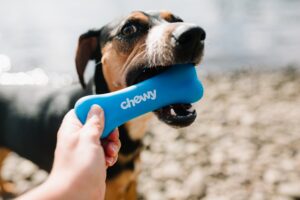We know for sure that dogs love to chew on bones. It makes them happy, relieves boredom and satisfies their innate urge to chew. But is it really safe for dogs to chew bones?
With Christmas almost upon us, many people will have family dinners including lots of leg ham and other meats on the bone. While it may be tempting to give your pooch leftover meat and bones, this can be seriously detrimental to their health.
If you want to treat your dog over Christmas you may consider feeding them raw bones. In this article we’ll discuss the benefits of feeding your dog raw bones, as well as the potential risks. This will help you to be more informed when purchasing the correct bones for your dog.
Benefits
Bones are a good source of minerals and nutrients and a wonderful source of calcium and phosphorus and can be fed as part of a healthy diet.
 Chewing bones can help to keep your dog’s teeth clean and gums healthy. While it doesn’t replace regular visits to the veterinarian for dental cleaning, adding raw, fresh bones to your dog’s diet can reduce the incidence of canine tooth disease.
Chewing bones can help to keep your dog’s teeth clean and gums healthy. While it doesn’t replace regular visits to the veterinarian for dental cleaning, adding raw, fresh bones to your dog’s diet can reduce the incidence of canine tooth disease.
Chewing bones can also be mentally stimulating for dogs and increases serotonin levels, which can make for a happier dog.
Risks
One of the biggest mistakes people make when they give bones to their dogs is that they cook them. Cooked bones of any kind are dangerous because they can break into shards, and the small sharp pieces can cut into your dog’s mouth and cause internal injury to their digestive tract.
Ham and other salty meats are very dangerous to pets, so avoid giving your dog leftover meat or bones from the cooked meat. High in fat and salt content, these meats can cause serious stomach ache or pancreatitis.
Small bones such as chicken bones can also be dangerous. If your dog tries to swallow small bones, and they get stuck in their throat, they can have the bone stuck between their molars in the roof of their mouth.
Chewing on bones can also cause damage or fracture dog’s teeth. These fractures can be quite painful and often mean the tooth needs to be extracted.
What types of bones should you feed your dog?
Chewing bones can be safe, but can cause problems for your dog if your bone of choice is poor.
Most raw bones that have not been cooked are edible for your dog. Raw beef, chicken, lamb or turkey bones are soft enough to chew and digest.
Dogs with sensitive stomach, pancreas or weight problems should not be fed bones with excessive fat or bone marrow, as it adds too much fat to their diets.
Larger dogs should be given large bones, such as whole cow femur bones (e.g. 5 “or larger bones in the bone marrow or larger knuckles). Larger bones that allow your dog to chew more reduce the likelihood that it will break apart, lowering the risk of them swallowing dangerous chunks. If your dog starts to break off large pieces of bone or it becomes too small to chew, take the bone off them.
the bone off them.
For smaller dogs, it’s ok to give them large bones such as a sheep or cow femur bones – they may have a bit of trouble getting their mouth around them but it will keep them occupied for a while!
If you are concerned about the risks of feeding your dog bones, there are plenty of safe alternatives on the market, such as dental sticks and bone-shaped chew toys.
Bones can be fed as part of a healthy diet for your dog, but you must do so safely and be aware of the risks to ensure the wellbeing of your dog. Talk to your vet to decide if the benefits of giving your dog bone to chew outweigh the risks.